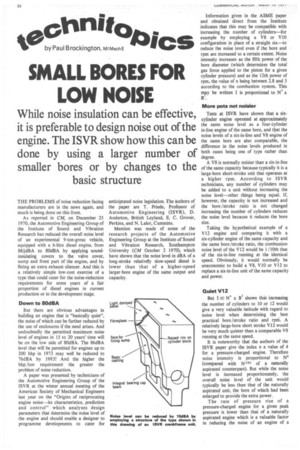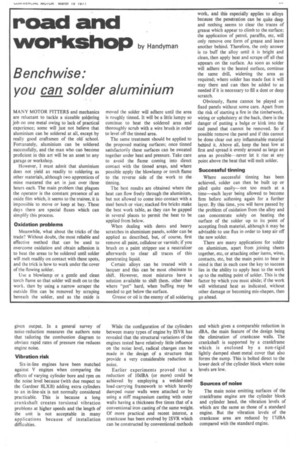te einitat ocs by Paul Brockington, miMechE
Page 34

Page 35

If you've noticed an error in this article please click here to report it so we can fix it.
SMALL BORES FOR LOW NOISE
While noise insulation can be effective, it is preferable to design noise out of the engine. The ISVR show how this can be done by using a larger number of smaller bores or by changes to the basic structure
THE PROBLEMS of noise reduction facing manufacturers are in the news again, and much is being done on this front.
As reported in CM, on December 25 1970, the Automotive Engineering Group of the Institute of Sound and Vibration Research has reduced the overall noise level of an experimental 9-ton-gross vehicle, equipped with a 6-litre diesel engine, from 881dBA to 80dBA by applying soundinsulating covers to the valve cover, sump and front part of the engine, and by fitting an extra exhaust silencer. And this is a relatively simple low-cost exercise of a type that could cater for the noise-reduction requirements for some years of a fair proportion of diesel engines in current production or in the development stage.
Down to 80dBA But there are obvious advantages in building an engine that is "basically quiet", the noise of which can be further reduced by the use of enclosures if the need arises. And undoubtedly the permitted maximum noise level of engines in 15 to 20 years' time will be on the low side of 80dBA. The 86dBA level that will be permitted for engines up to 200 bhp in 1973 may well be reduced to 76dBA by 1993! And the higher the bhp /ton requirement the greater the problem of noise reduction.
A paper was presented by technicians of the Automotive Engineering Group of the ISVR at the winter annual meeting of the American Society of Mechanical Engineers last year on the "Origins of reciprocating engine noise—its characteristics, prediction and control" which analyses design parameters that determine the noise level of the engine and should enable a designer to programme developments to cater for anticiptated noise legislation. The authors of the paper are T. Priecle, Professor of Automotive Engineering (ISVR), D. Anderton, British Leyland, E. C. Grover, Perkins, and N. Later, Cummins.
Mention was made of some of the research projects of the Automotive Engineering Group at the Institute of Sound and Vibration Research, Southampton University (CM October 2 1970), which have shown that the noise level in dBA of a long-stroke relatively slow-speed diesel is lower than that of a higher-speed larger-bore engine of the same output and capacity. Information given in the ASME paper and obtained direct from the Institute indicates that this may be compatible with increasing the number of cylinders—for example by employing a V8 or V10 configuration in place of a straight six—to reduce the noise level even if the bore and rpm are increased to a certain extent. Noise intensity increases as the fifth power of the bore diameter (which determines the total gas force applied to the piston for a given cylinder pressure) and as the 12th power of rpm, the value of n being between 2.8 and 3 according to the combustion system. This may be written I is proportional to 1%16 x B.
More pots not noisier Tests at ISVR have shown that a sixcylinder engine operated at approximately the same noise level as a four-cylinder in-line engine of the same bore, and that the noise levels of a six-in-line and V8 engine of the same bore are also comparable, the difference in the noise levels produced in both cases being one of type rather than degree.
A V8 is normally noisier than a six-in-line of the same capacity because typically it is a large-bore short-stroke unit that operates at a higher rpm. According to ISVR technicians, any number of cylinders may be added to a unit without increasing the noise level—other things being equal. If, however, the capacity is not increased and the bore /stroke ratio is not changed increasing the number of cylinders reduces the noise level because it reduces the bore size.
Taking the hypothetical example of a VI2 engine and comparing it with a six-cylinder engine of the same capacity and the same bore/stroke ratio, the combustion noise level of the V12 would be 1 /10th that of the six-in-line running at the identical speed. Obviously, it would normally be uneconomic to build a V8, VIO or V12 to replace a six-in-line unit of the same capacity and power.
Quiet V12 But I oC Nn x B5 shows that increasing the number of cylinders to 10 or 12 would give a very valuable latitude with regard to noise level when determining the best practical bore /stroke ratio and rpni. A relatively large-bore short stroke V12 would be very much quieter than a comparable V8 running at the same speed.
It is noteworthy that the authors of the ISVR paper give the index n a value of 4 for a pressure-charged engine. Therefore noise intensity is proportional to N4 (compared with N 2'86 of a naturally aspirated counterpart). But while the noise level is increased proportionately, the overall noise level of the unit would typically be less than that of the naturally aspirated unit, the bore of which had been enlarged to provide the extra power.
The rate of pressure rise of a pressure-charged engine for a given peak pressure is lower than that of a naturally aspirated engine which is a valuable factor in reducing the noise of an engine of a given output. In a general survey of noise-reduction measures the authors note that tailoring the combustion diagram to obviate rapid rates of pressure rise reduces engine noise.
Vibration risk Six-in-line engines have been matched against V engines when comparing the effects of varying cylinder bore and rpm on the noise level because (with due respect to the Gardner 81.,XB) adding extra cylinders to an in-line-six is not normally considered practicable. This is because a long crankshaft creates torsional• vibration problems at higher speeds and the length of the unit is not acceptable in many applications because of installation difficulties. While the configuration of the cylinders between many types of engine by ISVR has revealed that the structural variations Of the engines tested have relatively little influence on the noise level, radical changes can be made in the design of a structure that provide a very considerable reduction in noise.
Earlier experiments proved that a reduction of 10dBA (or more) could be achieved by employing a welded-steel load-carrying framework to which heavily damped outer walls were attached or by using a stiff magnesium casting with outer walls having a thickness five times that of a conventional iron casting of the same weight. Of more practical and recent interest, a crankcase has been evolved by ISVR which can be constructed by conventional methods and which gives a comparable reduction in dBA, the main feature of the design being the elimination of crankcase walls. The crankshaft is supported by a crankframe which is enclosed by a non-rigid lightly damped sheet-metal cover that also forms the sump. This is bolted direct to the lower deck of the cylinder block where noise levels are low.
Sources of noise The main noise emitting surfaces of the crankframe engine are the cylinder block and cylinder head, the vibration levels of which are the same as those of a standard engine. But the vibration levels of the crankcase area are reduced by I 7dBA compared with the standard engine.




























































































